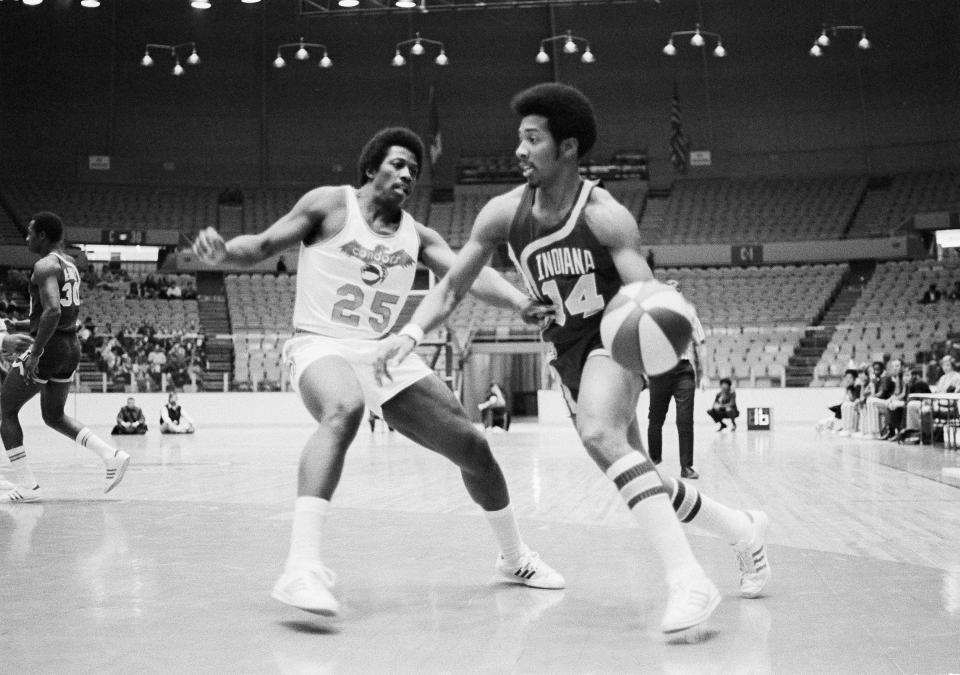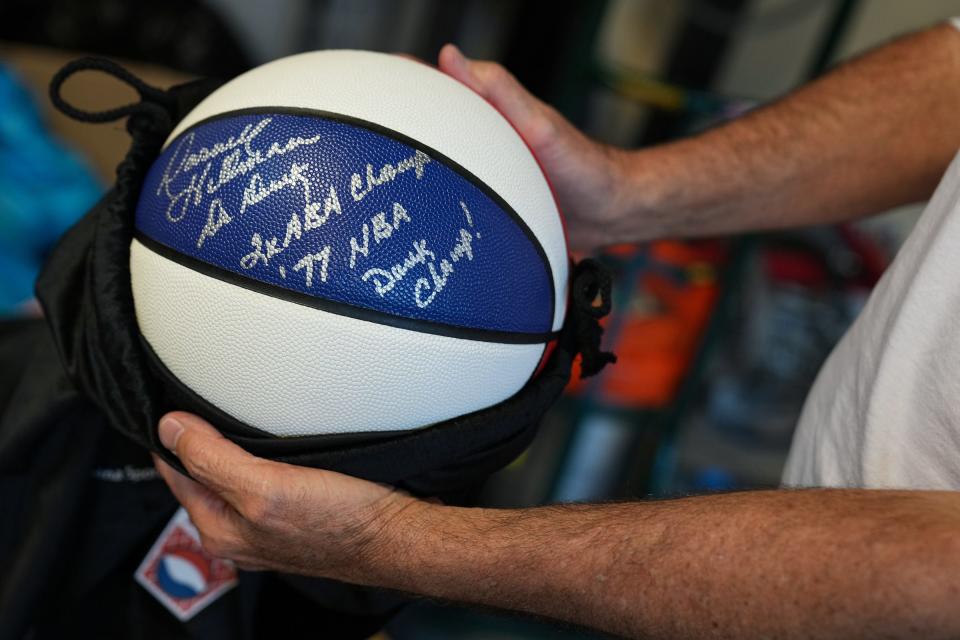‘Why not use the show ball?’: How a red, white & blue ball paved way for NBA All-Star Game
The orange basketball spins with velocity and frequency out of the hands of shooters like Steph Curry, Damian Lillard and Tyrese Haliburton. The shots tend to blur together.
But at one point in time, the basketball itself was a spectacle.
A red, white and blue basketball used to spin out of the hands of jump shooters in the American Basketball Association, which lasted from 1967-76. The league was often dominated by the Pacers, who won three of its 10 championships. Through a merger, it gave birth in some ways to a more surging NBA, passing along traditions such as the 3-point line and the dunk contest.
It did not pass along the America-themed basketballs, save for the 3-point contest at the All-Star Game.
George Karl would like to see that change. The Hall-of-Fame coach would like to see the ABA-style ball used at the NBA All-Star Game, starting this weekend in Indianapolis, home of those Pacers teams that once wreaked havoc upon the sport.
"I'll be honest with you: I think the ABA ball was better than the NBA ball," said Karl, who played for the Spurs in the ABA before coaching the Cavaliers, Warriors, SuperSonics, Bucks, Nuggets and Kings to a combined 1,175 career wins in the NBA. "I've never been a fan of the NBA ball. I think it's a hard ball."

But it's not just about aesthetics or texture. Not to a man so steeped in the history of both leagues.
"In the 70s, when the (ABA and NBA) merger occurred, basketball was not a healthy sport. It was struggling. The ABA was struggling, the NBA was struggling," Karl said. "... The merger, in many ways, saved the NBA. If we would have kept battling each other, both sides might have lost."
This weekend's All-Star festivities will showcase where the sport has come, to a level with massive TV ratings, millionaire bench players and global icons. But there was a time when the sport was in need of a jolt, and a different color basketball became one of its trademarks as ABA stars like Julius Erving would slam it through a hoop.
It was the idea of George Mikan, the Hall-of-Fame player who had become commissioner of the new league. Mikan felt the brown leather basketball was too difficult to see far away from the court.
He wanted a ball that could stand out but also unify, and an American-themed one became the choice.
But it wasn't always popular. Players initially pushed back on the new ball, claiming it was either too big or too slippery.
The colored ball grew its own legend in a way. In one preseason game in Tucson, none of the colored basketballs were around, but the league was adamant that they had to showcase the color since it was the first game in the history of the Denver franchise, then-Denver coach Bob Bass said in Terry Pluto's book, "Loose Balls: The short, wild life of the American Basketball Association."
So, Bass said, they spray-painted the basketballs red, white and blue and went on to have 44 turnovers in the first half alone.
The league had to put out a press release defending the ball. Then-Pacers general manager Mike Storen told Pluto that at one point, he created a team rule that would fine any player who complained about the ball.
"When the league began, the ABA balls were far more slippery than the kind we were used to, for a very obvious reason ― they were new," Steve Jones, a three-time ABA All-Star, told Pluto. "All new balls, regardless of the color, are slippery. ... Since there never was a red, white and blue ball before, you couldn't have any used ones."
Perhaps our favorite image of the ABA pic.twitter.com/YIeUQcH1Lz
— ABAthrowbacks (@abathrowbacks) February 11, 2024
Though the ball was initially contentious, Mikan's vision was always for it to bring those in the sport together. The ABA preached fierce competition, but he wanted players and coaches to unite over the American symbol of the ball and the goal of watching it soar through a net.
Eventually, it caught on with more players.
"It took time to really get used to playing with the ball," said Freddie Lewis, who starred on all three Pacers championship teams and won the playoffs MVP in 1972. "They perfected the ball with the wide seams to make it as close to the NBA ball as they could... they perfected that ball to the point where we didn't think about the color anymore. We just thought about the feel of the ball and the way we could handle it."
Major attraction: How Larry Bird, an Indy car and a flawless hosting resume put NBA All-Star Game in Indy
The ball became a metaphor for the shifting nature of the sport. As spectators checked out this new 3-point line or this competition at All-Star Weekend known as the dunk contest, they watched a blur of red, white and blue soar from down the court or thunder through the net.
And the Pacers were often the team dominating with that ball. One of just two teams to last all nine seasons without a relocation or name change, the franchise won championships in the 1969-70, '71-'72 and '72-'73 seasons. Those banners now hang in Gainbridge Fieldhouse, marking the most recent titles the Pacers have won.
The glory on the court was everything for players who never became stars in a financial sense. Lewis joked that one year of a star's salary in the current game could have set the entire ABA up for life and retirement ― a hole the surviving characters are now feeling as they grow into their 70s and 80s.
"I definitely feel as if they did not recognize us enough," Lewis said. "They did not take care of us the way that they should have taken care of us with us being the founders of the whole thing, getting it started."

They're sharing their memories where they can. Amazon Prime Video has announced an upcoming four-part docuseries called "Soul Power," which will chronicle the nine years of the ABA.
The sport has grown massively since the days of the red, white and blue basketballs. The focus of the league now is primarily on its stars, but even in them, Karl sees flashes of those ABA days.
"Kevin Durant reminds me of George Gervin," Karl said, referencing the nine-time All-Star he played with on the Spurs.
"The guy down in Oklahoma City, SGA (Shai Gilgeous-Alexander), he reminds me of James Silas," Karl said, referencing a two-time All-Star. "(SGA) is very much a midrange jump-shooter. Silas wasn't a 3-point shooter, but he was an unbelievable scorer."
This weekend's All-Star Game festivities will symbolize the growth, from the way players drain 3-pointers not as a gamble but as a go-to move to the props they use to accentuate the dunk contest.
Both ideas came from the ABA, which had a kind of basketball that was revolutionary in its time, only to be ditched when the league merged with the NBA in 1977.
Karl would like to see a slice of that history honored in the All-Star Game. If not using the ball for the game, it could be used in the dunk contest or maybe in warm-ups, he said.
It would be different, but it wouldn't be new.
"To use it in the actual game, I think, would be a distraction to the people," Lewis said. "... But the All-Star Game is all show. So why not use the show ball?"
Contact Nate Atkins at natkins@indystar.com. Follow him on Twitter @NateAtkins_.
This article originally appeared on Indianapolis Star: How a red, white and blue basketball helped set up NBA All-Star Game

